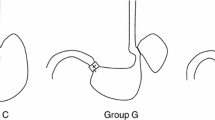Abstract
Our morphometric feline model of acid-induced esophageal damage histologically resembles human reflux esophagitis. The histologic scoring system includes intensity and linear extent of basal cell hyperplasia, intraepithelial and subepithelial segmented leukocytes, and ulcers. Each of these four categories is scored from 0 to 4, for a potential total score of 16. Some reports have indicated that the long-duration acid exposure episodes during recumbent nighttime reflux are apt to be associated with greater injury than shorter episodes during daytime upright exposure. We tested the hypothesis that longer single exposures to acid would incite greater morphologic damage in the cat than would multiple, shorter acid exposures. To study the influence of continuous versus intermittent hydrochloric acid exposure, groups of six cats each were infused continuously (single infusion) for 15, 20, or 30 min, and compared with cats infused for 2-min acid infusion times. Our studies indicate that total acid exposure and mucosal damage are more likely to be greater after multiple episodes of the same total duration with adequate clearing (ie, awake upright reflux) than after single long episodes of acid exposure that are poorly cleared (ie, sleeping).
Similar content being viewed by others
References
Demeester TA, Johnson LF, Joseph GJ, Toscano MS, Hall AW, Skinner DB: Patterns of gastroesophageal reflux in health and disease. Ann Surg 184:459–469, 1976
Eastwood CL, Castell DO, Higgs RH: Experimental esophagitis in cats impairs lower esophageal sphincter pressure. Gastroenterology 69:146–153, 1975
Higgs RH, Castell DO, Eastwood GL: Studies on the mechanism of esophagitis-induced lower esophageal sphincter hypertension in cats. Gastroenterology 71:51–57, 1976
Eastwood GL, Beck BD, Castell DO, Brown FC, Fletcher JR: Beneficial effect of indomethacin on acid-induced esophagitis in cats. Dig Dis Sci 26:601–608, 1981
Katz PO, Geisinger KR, Hassan M, Wu WC, Huang D, Castell DO: Acid-induced esophagitis in cats is prevented by sucralfate but not synthetic prostaglandin E. Dig Dis Sci 33:217–224, 1988
Geisinger KR, Cassidy KT, Nardi R, Castell DO: The histologic development of acid-induced esophagitis in the cat. Mod Pathol 3:619–624, 1990
Goldberg HI, Dodds WJ, Gee S: Role of acid and pepsin in acute experimental esophagitis. Gastroenterology 56:223–230, 1969
Author information
Authors and Affiliations
Rights and permissions
About this article
Cite this article
Cassidy, K.T., Geisinger, K.R., Kraus, B.B. et al. Continuous versus intermittent acid exposure in production of esophagitis in feline model. Digest Dis Sci 37, 1206–1211 (1992). https://doi.org/10.1007/BF01296561
Received:
Revised:
Accepted:
Issue Date:
DOI: https://doi.org/10.1007/BF01296561




